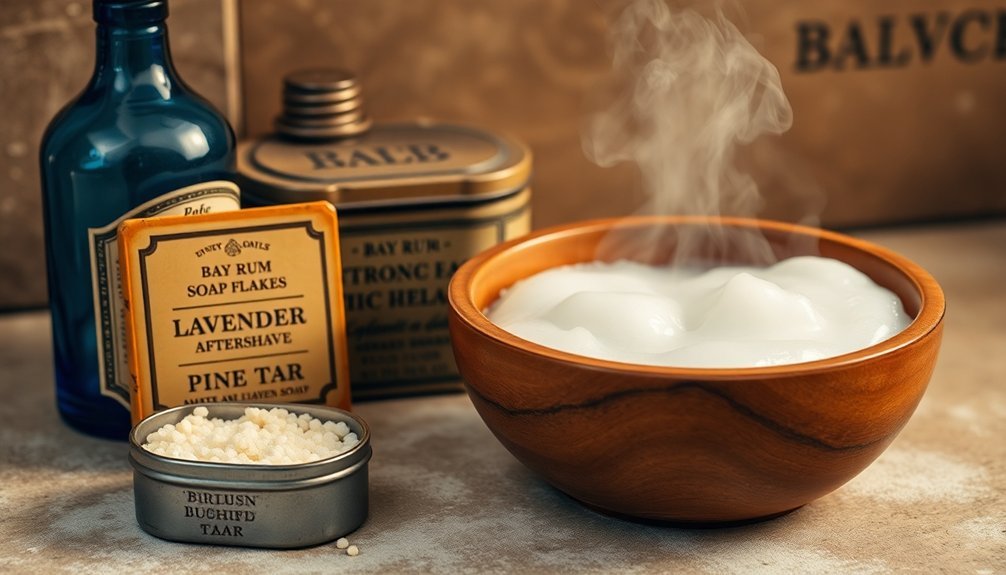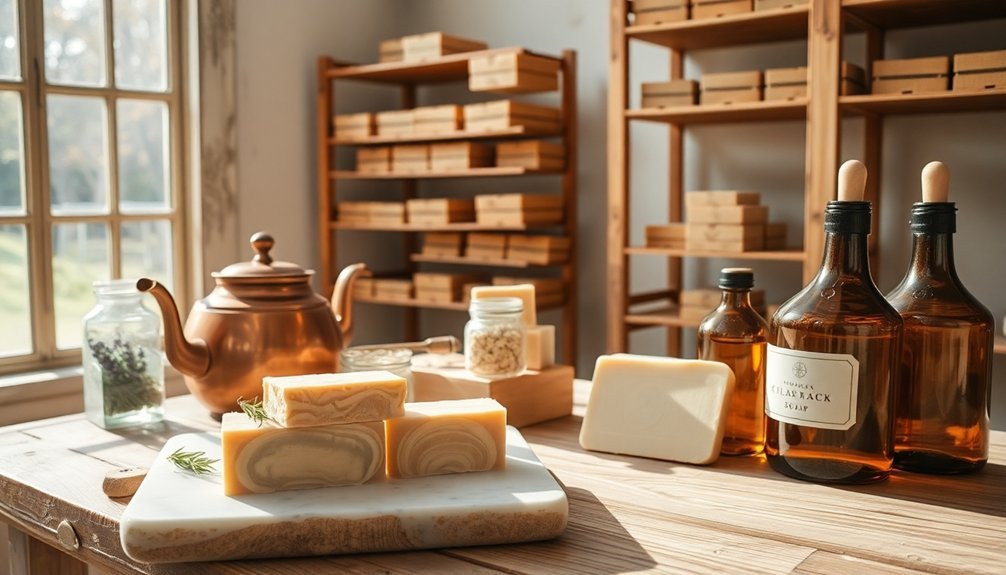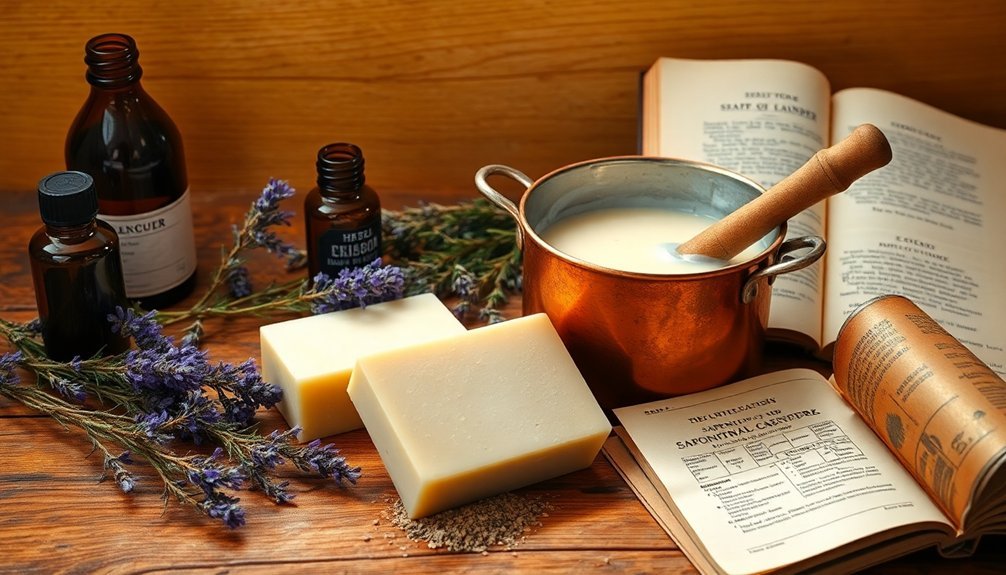Old-fashioned soaps smell different because they contain natural ingredients like tallow and essential oils that undergo oxidation over time. Unlike modern products with stable synthetic fragrances, traditional soaps feature complex scents that evolve as they age. The distinctive aroma comes from the saponification process, regional botanical additions, and traditional curing methods that allow chemical transformations. You'll discover how these time-honored production techniques create an aromatic experience that's impossible to replicate with today's mass-produced alternatives.
Why Do Old-Fashioned Soaps Smell So Different?

While you might expect vintage soaps to retain their original pleasant fragrances, they often develop distinctly different scents over time. This transformation occurs primarily because old-fashioned soaps typically contain tallow or animal fats that undergo rancidification, creating unusual odors unlike modern synthetic formulations.
The oxidation process affects natural ingredients in these vintage cleansers, degrading their original scent profiles. Traditional fragrance materials like essential oils and natural extracts fade or chemically alter with age, losing their intended pleasant aromas.
Environmental factors also play a role—decomposing packaging materials such as foil can allow soaps to absorb surrounding odors.
Chemical reactions continue throughout the aging process, converting original ingredients into compounds with entirely different scent characteristics, explaining why that bar of grandma's soap smells nothing like when it was first produced.
The Heritage of Natural Ingredients in Traditional Soap Making

Unlike today's mass-produced varieties, traditional soap making represents a rich cultural heritage built upon natural ingredients harvested directly from the environment.
When you handle an old-fashioned soap, you're connecting with centuries of craftsmanship that prioritized locally sourced components like tallow, plant oils, and herbs.
These artisanal soaps derive their distinctive scents from the saponification process itself, where natural ingredients transform chemically without synthetic additives.
Essential oils extracted from flowers and herbs replaced modern fragrance oils, creating authentic aromas that evolve over time. The lye used in traditional recipes also contributes earthy undertones that you won't find in contemporary products.
As fats and oils oxidize naturally, they develop character—what some might call rancidity, others recognize as the genuine signature of handcrafted soap's living heritage.
Essential Oils vs. Modern Synthetic Fragrances

You'll immediately notice that old-fashioned soaps using essential oils carry complex, evolving scents derived from natural plant sources, while modern synthetic fragrances offer consistent but often one-dimensional aromas.
These natural oils release their fragrance gradually as they oxidize and interact with your skin, creating a sensory experience that changes subtly throughout use.
In contrast, modern synthetic fragrances are engineered for stability and predictability, sacrificing the rich aromatic complexity and therapeutic benefits found in traditional soap formulations.
Natural vs. Synthetic Origins
The distinctive aroma of old-fashioned soaps often comes from their natural crucial oil foundations, creating those complex, earthy scents you can't quite replicate in modern products.
When you smell traditional cold process soap making results, you're experiencing the genuine aromatic compounds from plants rather than lab-created imitations.
Unlike synthetic fragrance oil that maintains stability over time, essential oils gradually transform as they oxidize, giving vintage soaps their ever-evolving scent profile.
The chemical richness of natural oils—containing dozens of aromatic compounds—provides depth that synthetic alternatives with fewer components simply can't match.
Traditional soap bases also frequently include tallow or other natural fats that contribute subtle aromatic notes, while modern synthetic surfactants lack these characteristic undertones.
You're fundamentally comparing nature's complete botanical symphony to a simplified laboratory recreation.
Scent Longevity Differences
When comparing scent staying power, essential oils in old-fashioned soaps typically provide an evolving aromatic journey rather than the persistent uniformity found in synthetic fragrances. You'll notice the scent profile of traditional soaps changes over time, developing depth and character as the soap ages.
| Characteristic | Essential Oils | Synthetic Fragrances |
|---|---|---|
| Initial Potency | Higher (0.8 oz/lb) | Often lower |
| Scent Evolution | Complex, maturing | Static, unchanging |
| Longevity Type | Subtle, fading gracefully | Consistent, sometimes artificial |
While synthetic fragrances maintain their scent longer, they lack the authentic complexity that makes vintage soaps special. Essential oils may fade more quickly due to oxidation, but their natural richness creates that nostalgic experience many find superior—a genuine olfactory impression rather than a manufactured one.
Aromatic Profile Complexity
Exploring beyond mere longevity, the aromatic profiles of traditional soaps offer a rich tapestry of scents that modern synthetic alternatives struggle to match. When you use vintage soaps, you're experiencing natural essential oils containing diverse aromatic compounds that create multi-layered fragrances evolving on your skin.
Unlike today's uniform synthetic scents, old-fashioned soaps deliver complexity through their ingredients. The combination of animal fats like tallow with botanical essential oils produces distinctive aromatic signatures that tell a sensory story.
These natural elements interact uniquely with your body chemistry. The therapeutic properties of these essential oils add another dimension to vintage soap aromas. They don't just smell different—they engage your senses differently, creating an olfactory experience that synthetic fragrances, despite their consistency and stability, simply can't replicate.
The Chemistry Behind Traditional Saponification Aromas

Behind every nostalgic whiff of old-fashioned soap lies a complex chemical story. When fats meet alkali—typically sodium hydroxide—in traditional saponification, they create more than just soap; they generate a unique scent signature.
You'll notice that soaps made with tallow develop distinctly different fragrance profiles than those made with vegetable oils.
Time transforms these scents through oxidation. As your vintage soap ages, fatty acids break down, creating compounds that weren't present in the fresh product.
The essential oils that once dominated the fragrance gradually degrade or evaporate, revealing the base notes of the soap itself.
Even the production method influences aroma—cold process soaps retain more of their original scent compounds than hot process varieties because they're exposed to lower temperatures during manufacturing.
Time-Honored Botanical Ingredients That Define Classic Soap Scents

The garden's finest treasures have always found their way into traditional soap-making. When you use old-fashioned soaps, you're experiencing lavender, rosemary, and chamomile in their authentic forms—botanical ingredients that create distinctive, nostalgic aromas missing from modern alternatives.
Unlike contemporary soaps with synthetic fragrances, traditional soaps incorporate plant-derived essential oils that deliver genuine scent profiles. These natural components interact uniquely during the cold process method, developing complex fragrances as saponification occurs.
You'll notice how herbs and botanicals in classic soaps serve dual purposes—they don't just create memorable scents but also provide skin benefits.
This sensory experience is further enhanced when natural ingredients like tallow create a creamier, richer aroma compared to today's palm or coconut oil bases.
How Curing Methods Affect the Aromatic Profile of Vintage Soaps
You'll notice vintage soaps possess a distinctive scent profile largely shaped by traditional air-drying techniques that allow for extended oxidation and chemical maturation.
These time-honored methods typically abandon modern preservatives in favor of natural curing processes, often lasting months rather than the weeks common in contemporary soap production.
The absence of synthetic stabilizers means the soap's aromatic compounds evolve considerably over decades, creating that characteristic "old-fashioned" smell that can't be replicated in today's mass-produced alternatives.
Traditional Air-Drying Methods
While modern soap manufacturing often rushes products to market, traditional air-drying methods reveal why vintage soaps possess such distinctive aromas. When you allow handmade soaps to cure for 4-6 weeks in cool, dry environments, you're not just drying them—you're developing their unique scent signature.
During this patience-testing period, saponification continues, transforming ingredients and mellowing the fragrance. The process allows excess moisture to evaporate and volatile compounds to stabilize, creating a more nuanced aromatic profile.
You'll notice how environmental factors like humidity, temperature, and air circulation greatly impact the final result.
As your soap ages, chemical reactions cause certain scent notes to fade while others become more pronounced—explaining why vintage soaps smell so different from their modern counterparts that haven't enjoyed this unhurried transformation.
Preservative Evolution Over Decades
As formulations have evolved throughout the past century, preservatives play an essential role in determining why your grandmother's soap smells dramatically different from today's bars.
The absence of modern fragrance stabilizers in vintage soaps created more volatile scents that changed dramatically over time.
When comparing vintage soaps to contemporary formulations, you'll notice three key differences:
- Vintage soaps relied on natural ingredients without synthetic preservatives, resulting in shorter shelf lives and evolving aromatic profiles.
- Traditional cold process methods allowed natural saponification to enhance scents initially, but also led to faster deterioration.
- Tallow-based ingredients in older soaps oxidized more readily, developing distinctive (sometimes rancid) notes that you won't find in today's plant-based alternatives.
These preservation differences explain why that bar from grandma's cupboard carries a unique olfactory signature unlike anything on modern shelves.
Regional Variations in Traditional Soap Scenting Practices
Traditional soap fragrances tell stories of geography and culture, varying dramatically from one corner of the world to another.
When you smell an old-fashioned Mediterranean soap, you're really experiencing the region's abundant olive oil infused with local citrus and rosemary, creating vibrant, fresh fragrances that reflect sunny coastlines.
Eastern European soaps offer a stark contrast with their tallow-based formulations and heavier, earthier scents derived from indigenous plants and flowers.
The fragrance profile tells the story of available resources and cultural preferences.
In Asia, soap-making traditions incorporate distinctive ingredients like rice and green tea, resulting in lighter, herbal aromas that differ considerably from Western counterparts.
These regional scenting variations highlight how traditional soap-makers worldwide relied on locally available materials, embedding their environment's essence into everyday cleansing rituals.
The Lost Art of Tallow and Lard-Based Soap Fragrances
Before modern plant-based alternatives dominated store shelves, tallow and lard-based soaps formed the backbone of cleansing rituals across generations.
These animal fat-derived products carried distinct aromas that you won't find in today's synthetic offerings.
When you encounter vintage soaps, you'll notice their unique scent profiles stem from three key factors:
- Oxidation effects – Tallow components naturally oxidize over time, creating what you might perceive as rancid notes reminiscent of old butter.
- Faded fragrances – Original essential oils deteriorate, leaving behind the raw, earthy base notes of the animal fats.
- Incomplete saponification – Imperfect processing sometimes left trace unsaponified fats that developed stronger odors as they aged.
This lost aromatic heritage represents more than just cleansing—it's a sensory connection to traditional craftsmanship that's rapidly disappearing from our daily experience.
Reviving Historical Soap Scents for Modern Sensibilities
When artisans attempt to resurrect historical soap scents today, they're faced with a delicate balancing act between authenticity and appeal.
You'll find that restoring vintage formulations often requires scraping away oxidized layers or exposing aged bars to sunlight to revitalize their dormant fragrances.
To capture these unique fragrances while pleasing modern noses, many craftspeople incorporate traditional ingredients like herbs and floral essences alongside the authentic tallow base.
This hybrid approach honors historical soaps while addressing contemporary preferences for milder scent profiles.
Connecting with vintage soap enthusiasts can provide valuable techniques for blending nostalgia with present-day sensibilities.
Through these communities, you'll discover methods that preserve the character of old-fashioned saponification while eliminating the rancid notes that modern consumers typically reject.
The goal isn't perfect replication but rather a respectful interpretation of soap-making heritage.
Frequently Asked Questions
Why Does My Soap Smell Different?
Your soap smells different because it's undergone oxidation over time. Ingredients break down, especially tallow-based ones, creating rancid odors. You'll notice this change particularly in older soaps that haven't been properly stored.
What Soap Gets Rid of Old People's Smell?
Soaps with strong fragrances like citrus, lavender, or tea tree oil can help mask "old people's smell." You'll want fresh products with antibacterial properties rather than vintage soaps that might already have developed unpleasant odors themselves.
What Ingredient Makes Soap Smell Good?
Fragrance oils and essential oils make your soap smell good. You'll find popular options like lavender, citrus, and eucalyptus in many soaps. Kaolin clay helps retain these scents longer during use.
What Does Rancid Soap Smell Like?
Rancid soap smells like spoiled fat or sour milk. You'll notice it's lost its pleasant fragrance and instead emits an unpleasant odor that's often described as "off," similar to rotten butter or old cooking oil.
In Summary
You've discovered that old-fashioned soaps smell different because they're crafted with natural ingredients, traditional saponification processes, and essential oils rather than synthetic fragrances. The unique aromas come from time-honored botanicals, specific curing methods, and regional ingredients like tallow or lard. While modern soaps prioritize consistency and longevity, you can still find artisanal soaps that capture these distinctive historical scents, bridging yesterday's craftsmanship with today's appreciation for authentic fragrances.





Leave a Reply